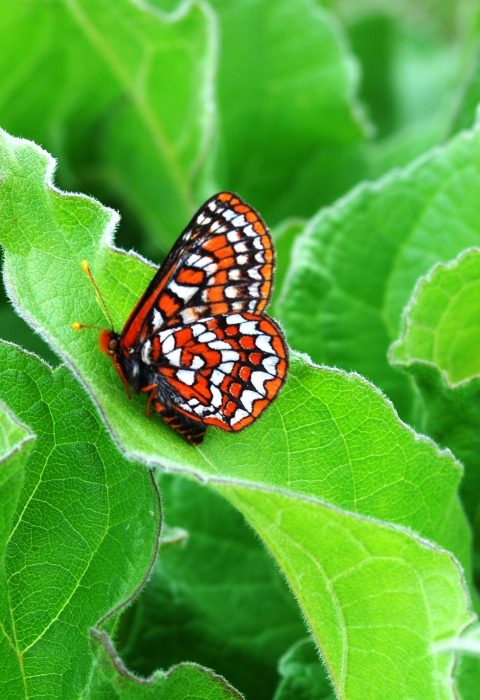Overview
Once found throughout native prairies of western Washington, Oregon and southwest British Columbia, Taylor's checkerspot butterfly is endemic to the Pacific Northwest. The decline of this butterfly accompanied the loss of prairie ecosystems in the region, and it is currently only found at a small handful of sites.
Scientific Name
Identification Numbers
Characteristics
Habitat
Habitat requirements for Taylor's checkerspot consist of open prairies and Garry oak meadows and balds, where abundant food plants are available for larvae and adult feeding. These sites include inland prairies on post-glacial, gravelly outwash, coastal bluffs and balds. Northwest grasslands were previously more widespread, larger and interconnected - conditions that likely would have supported a greater distribution and abundance of Taylor's checkerspot. However, those ecosystems have diminished over time due to development, agriculture, and fire suppression. Throughout the entire range of the Taylor’s checkerspot, prairie habitat was historically maintained through frequent burning by Indigenous peoples.
Ecosystem with large, flat areas of grasses.
Food
In Washington and Oregon, the adults lay eggs and larvae feed on native plants from the broomrape (Orobanchaceae) family (Castilleja hispida, C. levisecta) in addition to the non-native ribwort plantain. Several annual species are documented as larval host foods, including several species of speedwell (Veronica spp), blue-eyed Mary (Collinsia grandiflora and C. parviflora) and sea blush (Plectritus congesta). The two remaining populations in Oregon also depend upon P. lanceolata, however, golden paintbrush (C. levisecta) has been planted where Taylor’s checkerspots are found and they have been documented using the species for egg laying and as a larval food resource. Adults will feed on numerous species that bloom during their flight period, but Balsamorhiza deltoidea, Lomatium triternatum, Micranthes integrifolia and Camassia quamash are particularly important.
Physical Characteristics
In Washington and Oregon, the adults lay eggs and larvae feed on native plants from the broomrape (Orobanchaceae) family (Castilleja hispida, C. levisecta) in addition to the non-native ribwort plantain. Several annual species are documented as larval host foods including several species of speedwell (Veronica spp), blue-eyed Mary (Collinsia grandiflora and C. parviflora) and sea blush (Plectritus congesta). The two remaining populations in Oregon also depend upon P. lanceolata, however, golden paintbrush (C. levisecta) has been planted where Taylor’s checkerspots are found and they have been documented using the species for egg laying and as a larval food resource. Adults will nectar on numerous species that bloom during their flight period but Balsamorhiza deltoidea, Lomatium triternatum, Micranthes integrifolia, and Camassia quamash are particularly important.
Taylor's checkerspot is a medium-sized butterfly with a wing span of 5.7 centimeters (2.25 in)
The butterfly is conspicuously checkered with an orange to brick red, black and cream checkered pattern. The ventral surface of the wings are primarily black and orange with bands of cream cells. The dorsal portion of the wings has a proportionate mix of black, orange and cream. It is one of the smallest of the Edith’s checkerspots with short, stubby wings.
Life Cycle
Taylor’s checkerspots produce one brood per year. Adults emerge in the spring, usually during April and May, with a peak flight period from 10 to 14 days, with an overall flight period of about 30 days. Adults mate and the female may produce a few hundred eggs and lay clusters of 20 to approximately 100 eggs on the undersides of host plants. Larvae emerge and normally form five instars before entering diapause, a state of delayed development in which resource consumption slows drastically and physical development halts, in mid-June to early July. Post-diapause, by February, larvae emerge to feed and may disperse up to 10 meters a day, as they seek food and pupation sites. During post-diapause larval dispersal, larvae are protected by concealment and the defensive bitter chemicals sequestered from their host food plants.
Geography
Before its decline, Taylor’s checkerspot was documented at more than 70 sites in British Columbia, Washington and Oregon. This is very likely a substantial undercount, because their habitat was widespread and most areas were converted to agriculture and other uses before they were surveyed for butterflies. These sites included coastal and inland grasslands or prairies on southern Vancouver Island and surrounding islands in British Columbia, and the San Juan Island archipelago, as well as open prairies on post-glacial gravelly outwash prairies and balds in Washington's Puget Trough and Oregon's Willamette Valley. In Oregon, there were 14 recorded sites from which this subspecies had been either collected or observed over the last century.
At the time of listing in 2013, several new populations were identified on the north Olympic Peninsula and there are now 11 populations in Washington, two in British Columbia and two in the Willamette Valley of Oregon, both in Benton County.
Timeline
Explore the information available for this taxon's timeline. You can select an event on the timeline to view more information, or cycle through the content available in the carousel below.
26 Items